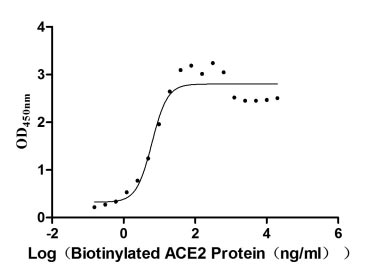Recombinant Mouse RNA polymerase II elongation factor ELL3 (Ell3)
-
中文名稱:小鼠Ell3重組蛋白
-
貨號(hào):CSB-YP768889MO
-
規(guī)格:
-
來(lái)源:Yeast
-
其他:
-
中文名稱:小鼠Ell3重組蛋白
-
貨號(hào):CSB-EP768889MO
-
規(guī)格:
-
來(lái)源:E.coli
-
其他:
-
中文名稱:小鼠Ell3重組蛋白
-
貨號(hào):CSB-EP768889MO-B
-
規(guī)格:
-
來(lái)源:E.coli
-
共軛:Avi-tag Biotinylated
E. coli biotin ligase (BirA) is highly specific in covalently attaching biotin to the 15 amino acid AviTag peptide. This recombinant protein was biotinylated in vivo by AviTag-BirA technology, which method is BriA catalyzes amide linkage between the biotin and the specific lysine of the AviTag.
-
其他:
-
中文名稱:小鼠Ell3重組蛋白
-
貨號(hào):CSB-BP768889MO
-
規(guī)格:
-
來(lái)源:Baculovirus
-
其他:
-
中文名稱:小鼠Ell3重組蛋白
-
貨號(hào):CSB-MP768889MO
-
規(guī)格:
-
來(lái)源:Mammalian cell
-
其他:
產(chǎn)品詳情
-
純度:>85% (SDS-PAGE)
-
基因名:Ell3
-
Uniprot No.:
-
別名:Ell3RNA polymerase II elongation factor ELL3
-
種屬:Mus musculus (Mouse)
-
蛋白長(zhǎng)度:full length protein
-
表達(dá)區(qū)域:1-395
-
氨基酸序列MEGTQEALSG KMRLLFTPAA RTSLLMLRLN EAALRALQEC QQQQVRPVIA FQGHRGYLRF PGPGWSCLFS FIVSQCGQEG TNGGLDLVYQ RLGRSGPNCL HCLGSLRERL TIWAAMDTIP APLLAQEHLT EGTRESESWQ DTGDEPEGHP QLAPDEVSDP LASHHEQSLP GSSSEPMAQW EMRNHTYLPS REPDQSLLSP ASQKRLDKKR SAPITTEEPE EKRLRALPLA SSPLQGLANQ DSQEGEDWGQ DEDEEGDEDG DSRLEQSLSA PSASESPSPE EVPDYLLQYR AIHSTEQQQA YEQDFETDYA EYRILHARVG AASQRFTELG AEIKRLQRGT PEHKVLEDKI VQEYKKFRKR YPSYREEKHR CEYLHQKLSH IKGLILEFEE KNRGS
-
蛋白標(biāo)簽:Tag?type?will?be?determined?during?the?manufacturing?process.
The tag type will be determined during production process. If you have specified tag type, please tell us and we will develop the specified tag preferentially. -
產(chǎn)品提供形式:Lyophilized powder
Note: We will preferentially ship the format that we have in stock, however, if you have any special requirement for the format, please remark your requirement when placing the order, we will prepare according to your demand. -
復(fù)溶:We recommend that this vial be briefly centrifuged prior to opening to bring the contents to the bottom. Please reconstitute protein in deionized sterile water to a concentration of 0.1-1.0 mg/mL.We recommend to add 5-50% of glycerol (final concentration) and aliquot for long-term storage at -20℃/-80℃. Our default final concentration of glycerol is 50%. Customers could use it as reference.
-
儲(chǔ)存條件:Store at -20°C/-80°C upon receipt, aliquoting is necessary for mutiple use. Avoid repeated freeze-thaw cycles.
-
保質(zhì)期:The shelf life is related to many factors, storage state, buffer ingredients, storage temperature and the stability of the protein itself.
Generally, the shelf life of liquid form is 6 months at -20°C/-80°C. The shelf life of lyophilized form is 12 months at -20°C/-80°C. -
貨期:Delivery time may differ from different purchasing way or location, please kindly consult your local distributors for specific delivery time.Note: All of our proteins are default shipped with normal blue ice packs, if you request to ship with dry ice, please communicate with us in advance and extra fees will be charged.
-
注意事項(xiàng):Repeated freezing and thawing is not recommended. Store working aliquots at 4°C for up to one week.
-
Datasheet :Please contact us to get it.
靶點(diǎn)詳情
-
功能:Enhancer-binding elongation factor that specifically binds enhancers in embryonic stem cells (ES cells), marks them, and is required for their future activation during stem cell specification. Elongation factor component of the super elongation complex (SEC), a complex required to increase the catalytic rate of RNA polymerase II transcription by suppressing transient pausing by the polymerase at multiple sites along the DNA. Component of the little elongation complex (LEC), a complex required to regulate small nuclear RNA (snRNA) gene transcription by RNA polymerase II and III. Does not only bind to enhancer regions of active genes, but also marks the enhancers that are in a poised or inactive state in ES cells and is required for establishing proper RNA polymerase II occupancy at developmentally regulated genes in a cohesin-dependent manner. Probably required for priming developmentally regulated genes for later recruitment of the super elongation complex (SEC), for transcriptional activation during differentiation. Required for recruitment of P-TEFb within SEC during differentiation. Probably preloaded on germ cell chromatin, suggesting that it may prime gene activation by marking enhancers as early as in the germ cells. Promoting epithelial-mesenchymal transition (EMT).
-
基因功能參考文獻(xiàn):
- Study found that Ell3, a member of the Ell (eleven-nineteen lysine-rich leukemia gene) family of RNA Pol II elongation factors, occupies enhancers in embryonic stem cells. PMID: 23273992
- The present results suggest that Ell3 promotes the differentiation of mouse embryonic stem cells by activating the expression of epithelial-mesenchymal transition-related genes and by suppressing p53 expression. PMID: 22768269
-
亞細(xì)胞定位:Nucleus.
-
蛋白家族:ELL/occludin family
-
組織特異性:Actively expressed in embryonic stem cells (ES cells), while it is weakly expressed in differentiated cells.
-
數(shù)據(jù)庫(kù)鏈接:
Most popular with customers
-
Recombinant Human Angiotensin-converting enzyme 2 (ACE2), partial,Biotinylated (Active)
Express system: Mammalian cell
Species: Homo sapiens (Human)
-
Express system: Mammalian cell
Species: Homo sapiens (Human)
-
Recombinant Rabbit Tissue factor pathway inhibitor (TFPI) (Active)
Express system: Mammalian cell
Species: Oryctolagus cuniculus (Rabbit)
-
Recombinant Human Intestinal-type alkaline phosphatase (ALPI) (Active)
Express system: Mammalian cell
Species: Homo sapiens (Human)
-
Recombinant Rat Intestinal-type alkaline phosphatase 1 (Alpi) (Active)
Express system: Mammalian cell
Species: Rattus norvegicus (Rat)
-
Recombinant Human IL12B&IL12A Heterodimer Protein (Active)
Express system: Mammalian cell
Species: Homo sapiens (Human)
-
Recombinant Human Tumor-associated calcium signal transducer 2 (TACSTD2), partial (Active)
Express system: Mammalian cell
Species: Homo sapiens (Human)
-
Recombinant Human Cadherin-1(CDH1),partial (Active)
Express system: Mammalian cell
Species: Homo sapiens (Human)

















